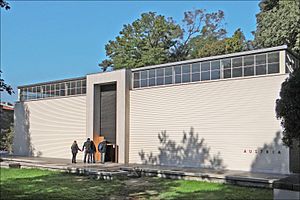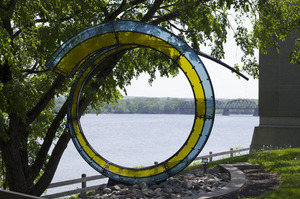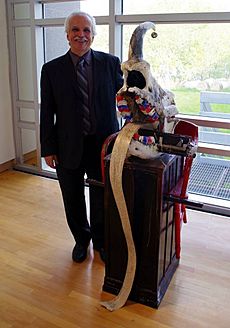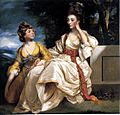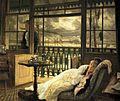Beaverbrook Art Gallery facts for kids
| Musée des beaux-arts Beaverbrook | |
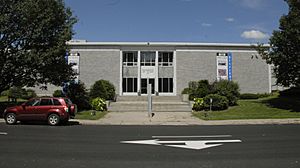
Beaverbrook Art Gallery in 2014.
|
|
| Established | 1959 |
|---|---|
| Location | 703 Queen Street Fredericton, New Brunswick, Canada |
| Type | Art museum |
| Collection size | 6,000 works (2018) |
| Visitors | 38,960 (2018) |
| Founder | William Maxwell "Max" Aitken, 1st Baron Beaverbrook |
| Public transit access | 16N Marysville (Fredericton Transit) |
| Nearest car park | Queen Street, East End Parking Garage |
The Beaverbrook Art Gallery, often called The Beaverbrook, is a public art gallery in Fredericton, New Brunswick, Canada. It is the official provincial art gallery for New Brunswick.
The gallery is named after William Maxwell "Max" Aitken, Lord Beaverbrook. He was a powerful businessman and politician who gave the money to build the gallery. He also gathered the first collection of art for it.
When the gallery opened in 1959, it had over 300 artworks. These included famous paintings by artists like J. M. W. Turner and Salvador Dalí. Over the years, the building has been expanded several times to make more room for art and visitors.
Contents
A Growing Home for Art
In 1954, Lord Beaverbrook offered to build an art gallery for the people of New Brunswick. The government accepted his offer and gave him land across the street from the New Brunswick Legislative Building.
The original building was a modern, one-story structure. It was designed to have a large central gallery with two smaller galleries on each side.
Major Expansions
The gallery has grown a lot since it first opened.
- 1983: Two new wings were added to the east and west sides of the building. These additions created space for collections of china and other decorative arts.
- 1995: The Marion McCain Atlantic Gallery opened. This expansion was named in honor of the wife of a major New Brunswick businessman who helped fund the project.
- 2017: A large new pavilion was completed. This made the Beaverbrook the largest art gallery in the Atlantic region. The expansion added more gallery space, a studio for artists, a small theater, and a café. It also made the gallery easier to access for people with disabilities by adding an elevator and ramps.
The Sculpture Garden
Next to the gallery is a sculpture garden, which opened in 2009. It's an outdoor space where large sculptures are displayed. One of the first sculptures was The Birth of Venus by New Brunswick artist André Lapointe.
A sculpture called Awakening/Éveil by Marie-Hélène Allain has been on the gallery's front lawn since 1985. In 2015, the gallery added a famous sculpture called Arriving Home by American artist Dennis Oppenheim. A year later, a piece called King and Queen by Sorel Etrog was also installed.
The Gallery's Amazing Collection
The Beaverbrook Art Gallery's collection has grown from 300 works to over 6,000. It is divided into four main areas: British, Canadian, International, and New Brunswick art.
How the Collection Began
Lord Beaverbrook personally collected most of the original 300 paintings. He had help from art experts to choose the best pieces. The collection included works by famous British artists from the 18th and 19th centuries, like J. M. W. Turner and John Constable. He also collected art from modern artists he knew, such as Augustus John and Graham Sutherland.
One of the most famous paintings he bought was Hotel Bedroom by Lucian Freud.
Before the gallery even opened, it received important gifts of art. A businessman from Toronto donated 22 paintings by Cornelius Krieghoff. Lady Dunn, who later married Lord Beaverbrook, gave three portraits by Walter Sickert and three works by Salvador Dalí.
One of the Dalí paintings is Santiago El Grande. It is a huge painting, measuring 13 by 10 feet (about 4 by 3 meters). It shows Spain's patron saint, Saint James the Great, riding a white horse. It has been a centerpiece of the gallery since it opened.
What's in the Collection Today
The gallery's collection continues to grow. The Canadian Collection features art from the 19th and 20th centuries, including works by the Group of Seven, Emily Carr, and David Milne. There is a special focus on artists from the Atlantic provinces.
The International Collection includes art from Europe and America, with works dating from the 14th to the 20th centuries.
Because the Beaverbrook is New Brunswick's provincial art gallery, it has a special New Brunswick Collection. This collection includes art from the province's history, featuring works by Acadian, Maliseet, and Mi'kmaq artists.
In recent years, the gallery has added more modern and contemporary art. This includes many works by well-known First Nations artists. Between 2015 and 2016 alone, the gallery received over 2,000 new artworks from donors across Canada.
Selected Works
-
Bartolomeo Passarotti, Portrait of a Young Man, c. 16th century.
-
Joshua Reynolds, Portrait of Hester Thrale and her daughter Hester, c. 1777.
-
J. M. W. Turner, The Fountain of Indolence, 1834
-
David Roberts, View on the Tiber Looking Towards Mounts Palatine and Aventine, c. 1863
-
James Tissot, A Passing Storm, c. 1876.
Disagreements Over Ownership
In 2003, a major disagreement began over who legally owned many of the gallery's most valuable paintings. Lord Beaverbrook had used charitable groups, called foundations, to buy the art. Years later, these foundations claimed they still owned the paintings and wanted to sell some of them. The gallery argued that the paintings were permanent gifts and should stay in New Brunswick.
The disputes were complicated and involved two different foundations: one based in the United Kingdom and one in Canada.
The U.K. Foundation Dispute
The Beaverbrook U.K. Foundation wanted to take back and sell two of the most valuable paintings: The Fountain of Indolence by J.M.W. Turner and Hotel Bedroom by Lucian Freud. The value of these paintings had increased so much that the foundation said it could no longer afford the insurance.
The case went to arbitration, a way of solving disagreements outside of a courtroom. In 2007, a retired judge made a decision. He ruled that 85 of the 133 paintings were gifts and belonged to the gallery. The other 48 paintings were to be returned to the foundation. This meant the two most valuable paintings stayed at the gallery. After more legal steps, the two sides finally reached a private agreement in 2010, ending the dispute.
The Canadian Foundation Dispute
A second disagreement involved 78 paintings that had been donated by Lady Beaverbrook. The Beaverbrook Canadian Foundation also claimed ownership of these works.
This dispute was settled out of court in 2014. The gallery and the foundation agreed to split the artworks. The gallery kept 35 of the paintings, and the foundation kept 43. As part of the deal, the foundation agreed to leave its 43 paintings on long-term loan to the gallery, so they can still be seen by the public.
See also
- List of art museums
- List of museums in New Brunswick


